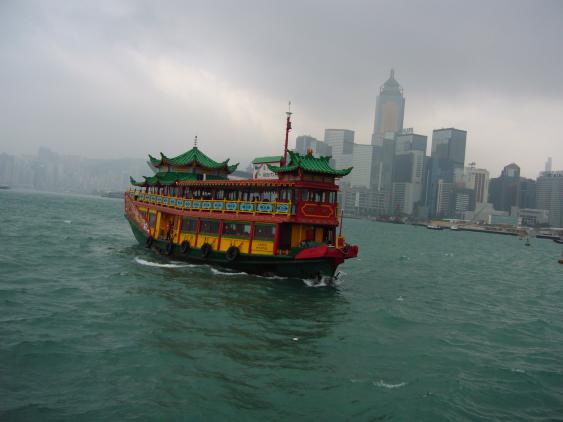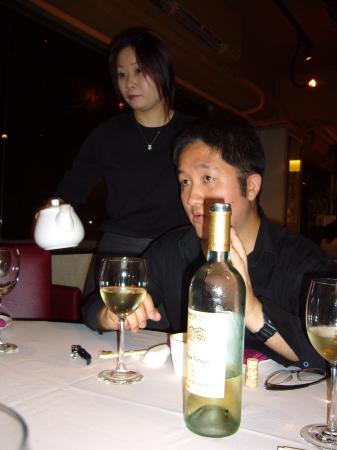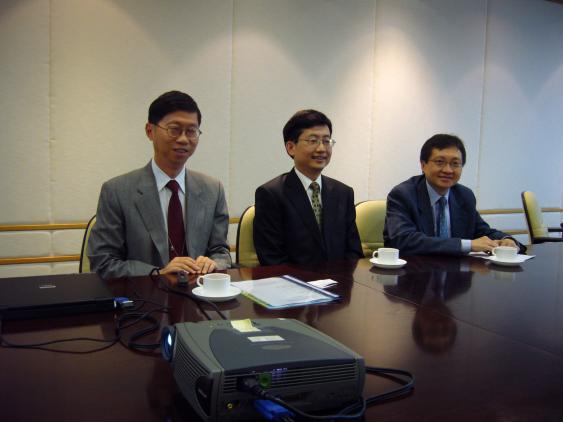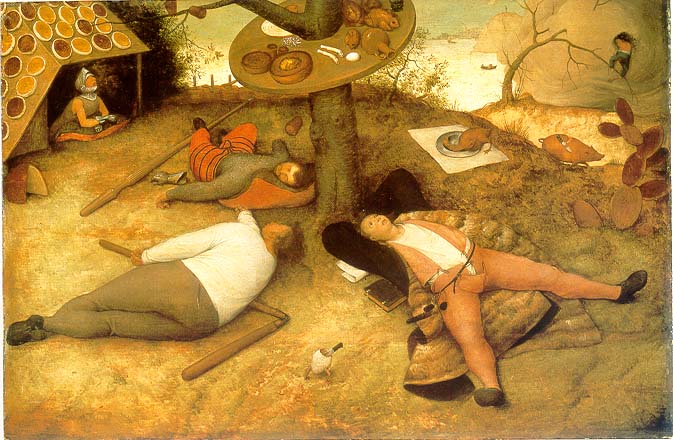After a week spent eating and drinking very well in Hong Kong, I am left with more questions than answers.
Eight is such an auspicious number for Chinese people that on 8/8/88 the lights in the newsroom of the South China Morning Post were dimmed and platters of chopped up suckling pig were carried in for a celebration. Allowing rookie Canadian journo Ross Meder (now turned Australian wine importer) to remember his arrival in the “fragrant harbor” of Hong Kong with a happy event. So if you’re going to produce a list of wine mysteries of the East, there should surely be eight.

Mystery #1: Chinese Wine is a Dragon
China plants as many new vines each year as comprise the SA national vineyard, yet the only Chinese wine I tasted last week was Deep Blue 06 from Grace Vineyards on the Cathay Pacific flight into Hong Kong. An experience the airhostess of colleague Helen Savage flying in from London advised against.
The observation by wine educator Kevin Tang, that “planting in China is just hearsay” notwithstanding, at each place we visited I dutifully asked for China wine and drew a blank each time: Berry Bros. & Rudd, the HK Jockey Club, Watson’s Wine Cellars, Crown Wine Cellars and Ross Meder’s Margaret River for Asia – but at least Ross has an excuse.
Even that energetic wine nationalist Simon Tam was temporarily out of tasting stock while New World importer David Roberts asked “why would you want to drink it? It’s 80% Chilean anyway.” A sentiment echoed by private client advisor James Rowell from Altaya Wines who noted “there is some truly shocking stuff made being made in China, often from non-noble cultivars. The whole business of wine labeling is very suspect: every red wine calls itself Cabernet Sauvignon. No one wants to drink Chinese wine. In the 4½ years I was managing the first branch of Watson’s Wine Cellar, the only people who ever asked for Chinese wine were Western tourists.”
Perhaps Chinese wines are dragons, which as John Lanchester pointed out in Fragrant Harbour (Faber, 2002), have an annoying habit of making themselves invisible at will.
Mystery # 2: Existence of a Chinese Palate
London’s International Wine and Spirit Competition certainly thinks there is as they’re assembling a tasting panel of Chinese palates for their November show and organizer Simon Tam confidently predicts “results 60-70% different than from a Western panel.” A contention contradicted by James Rowell who says bluntly “no, there is no Chinese palate” and confirms it by letting slip he was a little late for our meeting arranging delivery of a bottle of ’59 Gruaud-Larose (HK$ 8900) for a customer. Certainly with over 50% of wine imports from France and Nick Pegna, MD of Berry Bros. confirming that claret outsells every other brand 3:1, HK consumers behave like rich Bordelais, with the joke that HK is the capital of Bordeaux far from an empty one.

Mystery #3: Why a Wine Hub in HK
HK may be a natural jewel with over four times as many tourists a year as locals, yet it makes a curious choice as wine hub as the hot and humid climate is far from ideal for storing the stuff. A per capita annual wine consumption of 2 litres makes HK the city in the developed world with the lowest consumption, confirming that there is clearly no tradition of wine appreciation, at least among ordinary citizens.
The argument that fine dining was too expensive and impeding tourism on account of import duties also rings hollow when examples are quoted of Pinot Grigio marked up 600% in restaurants. As James Rowell notes “after the duty was scrapped, hotels and restaurants substituted higher quality wines at the same price points rather than reducing prices.”
On a different level entirely, Kevin Tang asks “what is a wine hub?”
Mystery #4: Why Wine with Chinese Food
Lau Chun, chef at private kitchen Yellow Door Kitchen, makes several points against serving wine with Chinese food:

• In Chinese culinary tradition, eating and drinking are essentially separate activities – there is no history of drinking fermented grape juice with a meal;
• A Chinese meal has no “main course” consisting rather of a succession of dishes complicating matching relatively few wines with relatively many courses;
• Presentation is less important making fancy stemware ridiculous;
• Strong flavours rule out subtle wines with yellow wine made from wheat often a better bet.
That said, Chun served up some of the most innovative food and wine matches of the week: 2001 Schlumberger Gewürztraminer Vendages Tardives Cuvée Christine with Shanghai stuffed duck, Pinto Grigio from the Alto Adige with pan fried pork neck in spicy vinaigrette and an Antonin Rodet Burgundy 2005with smoke pork rib with honey and tea leaves, Chun’s pièce de résistance.
Mystery #5: Why Western Wine
Nicolas Joly, the Buddha of Biodynamic wine making, raised an obvious point when he visited SA. “When I visit a country, I like to drink the wines of that country, not French imitations.” As the Cathay Pacific insert for Deep Blue 2006 notes “Grace Vineyards is situated in the centre of Shanxi Province, China, close to Tai Yuan, an area with a wine-making tradition that can be traced back to as early as the 7th century.” Long before vines were planted in Bordeaux.
Simon Tam reckons they were probably fermented from fruit or at least indigenous grape cultivars such as Zuoshan No 1, Shuangyou and Gongliang No 1. Why fly to HK to eat pizza?
Mystery #6: Do the Numbers Stack Up
Christopher Wong, Deputy Secretary for Commerce and Economic Development, presented some impressive statistics on wine growth forecasts for Asia (excluding Japan, a country Simon Tam admitted “no one can understand”). They presumably played a large role in prompting the HK government to abandon import duties last year and seem to be based largely on VinExpo/IWSR figures from 2006: the Asian market (excluding Japan) to grow from US$7 billion in 2007 to US$17 billion in 2012 to US$ 27 billion in 2017. Imports expected to reach US$ 1.5 billion by 2017 but these forecasts were made before the financial tsunami struck.
Now all bets are off with Boris de Vroomen, MD of Moët Hennessy Diageo, admitting to a sales decline in Champagne (David Roberts says a 60% fall over the Christmas period would not be far wrong) with “buyers trading down and collectors buying less of trying to liquidate part or all of their collections.” Just how robust a market in which only 17% of wine sales are sub-US$5 versus a global figure of 70%, remains to be seen.

Mystery #7: Who killed Manfred Schoeni
The 2009 edition of the Platter wine guide fails to list Ashanti as a producer while the telephone number in the 2008 edition has been disconnected. Raymond Tam, facilitator for our trip to HK had told us proudly that Ashanti was owned by HK investors.
My sources tell me that Ashanti was bought in the nineties by a consortium of 30 HK ex-pat and Chinese investors headed by art collector Manfred Schoeni who made his money buying art in China before it was popular to do so. The Schoeni Gallery in Old Bailey Street, HK, is now managed by daughter Nicole after Manfred was hacked to death in the Philippines villa la Dolce Vita of German property developer Antonne Faustenhause in 2004. Chopped up along with the Filipino maid was designer John James Hamish Cowperthwaite, son of Sir John Cowperthwaite, credited with setting up Hong Kong’s financial system while serving as financial secretary from 1961-71, according to The Times.
Mystery #8: What Happens Between Floors 9 and 39 at the Island Shangri-La Hotel
Assigned a pleasant berth on the 43rd floor of the Island Shangri-La hotel, the elevator and I became old friends and I couldn’t help but notive the buttons when straight from floor 8 to 40. What happened to the missing floors? Was this the converse of the Mertin Flemmer Building in Being John Malkovich which had a 7½ floor or platform 9¾ in Harry Potter?
One clue may be that the Director of Rooms at Shangri-La is Nathalie Cockayne. As Wikipedia notes, the Land of Cockayne was “a mythical medieval land of plenty, an imaginary place of extreme luxury and ease where physical comforts and pleasures are always immediately at hand and where the harshness of medieval peasant life does not exist.” Sounds pretty much like Hong Kong to me.




